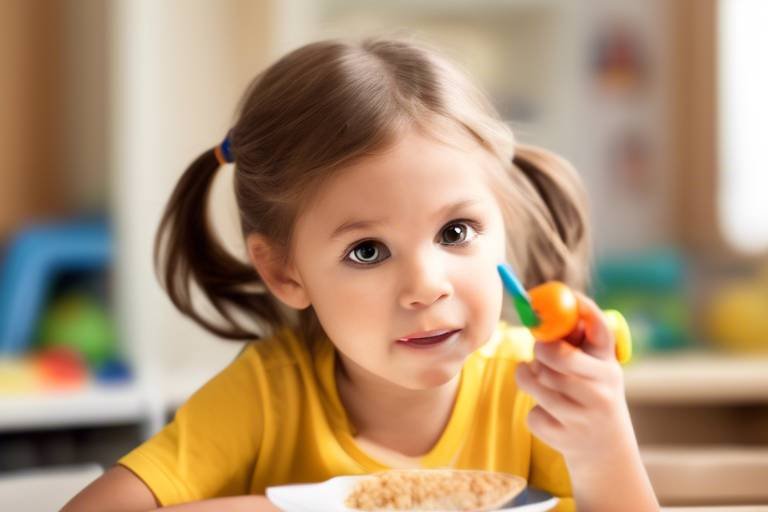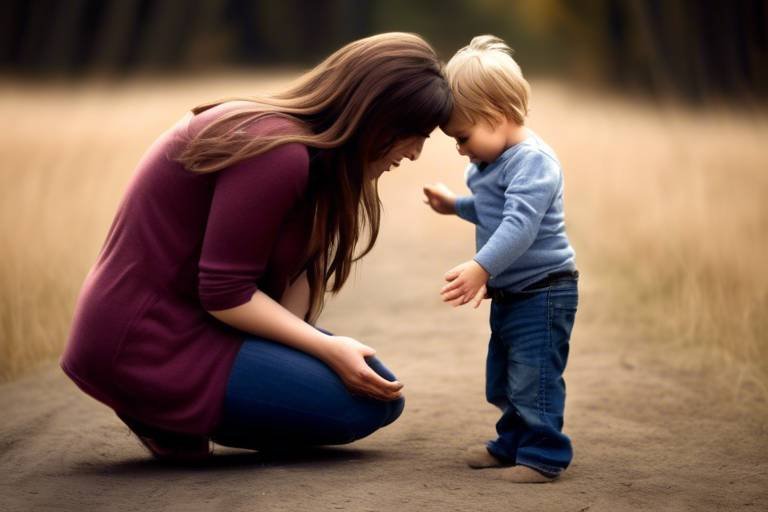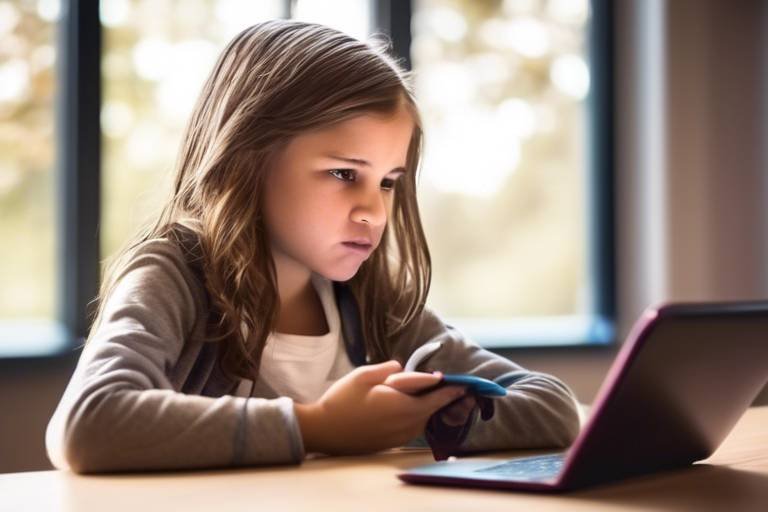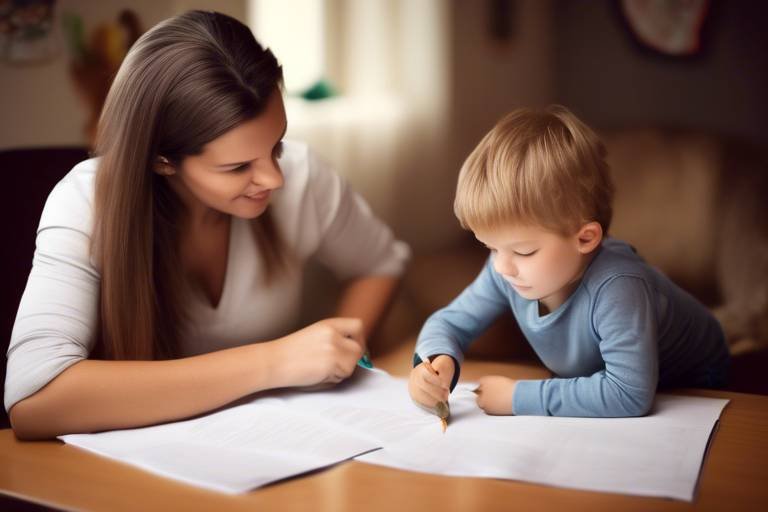Building Healthy Habits in Your Child
As parents, we all want the best for our children, right? One of the greatest gifts we can give them is the foundation of healthy habits. It’s not just about ensuring they eat their veggies or get outside to play; it’s about instilling a mindset that values nutrition, physical activity, and emotional well-being. These elements are crucial for their growth, development, and future success. Think of it as building a sturdy house: you need a solid foundation to support everything that comes after. So, how do we go about this? Let’s dive into some effective strategies that can make a lasting impact.
Teaching children about nutrition is like giving them a treasure map to a healthier life. When kids understand the importance of healthy eating, they’re more likely to make better food choices as they grow. Start by introducing a variety of foods, from colorful fruits to crunchy veggies. Make it fun! You could have a “rainbow plate” challenge where they try to include as many colors as possible on their plate. Not only does this make meals visually appealing, but it also ensures they’re getting a range of nutrients.
Consider the benefits of a balanced diet for young minds and bodies:
- Improved Concentration: Proper nutrition fuels the brain, enhancing focus and learning.
- Stronger Immunity: A well-rounded diet helps children fight off illnesses.
- Healthy Growth: Nutrients are essential for physical development and maintaining energy levels.
Let’s face it: kids have a natural energy that can sometimes feel like a tornado! Channeling that energy into physical activity is essential for their health. Regular exercise not only keeps them fit but also boosts their mood and helps them sleep better. The key is to make it enjoyable. If they associate exercise with fun, they’re more likely to stick with it.
Incorporating active play into daily routines can make exercise enjoyable for children. Instead of a boring workout, think of it as a grand adventure! Here are some creative suggestions:
- Organize a treasure hunt in the backyard.
- Turn on some music and have a dance party.
- Set up an obstacle course with household items.
These activities not only promote fitness but also strengthen family bonds and create lasting memories.
Exploring nature provides children with opportunities for physical activity and learning. Take them on hikes, bike rides, or even just a walk in the park. Nature is the ultimate playground! Activities like bird watching or scavenger hunts can make outdoor time educational and fun. Plus, being outside helps children connect with the world around them, fostering a sense of curiosity and adventure.
Participating in sports can enhance physical skills and teamwork. Introducing children to team sports can teach them valuable lessons about collaboration and discipline. Whether it’s soccer, basketball, or swimming, the benefits are immense. They not only get to stay active but also build friendships and learn how to work together towards a common goal. It’s like being part of a mini-community!
Establishing a consistent routine helps children understand the importance of health. Kids thrive on structure, and having a daily schedule that incorporates healthy eating and physical activity can make a world of difference. Set specific times for meals, snacks, and play. This not only helps them know what to expect but also reinforces the idea that taking care of their body is a priority.
Now, let’s not forget about the emotional side of things. Emotional health is just as important as physical health. Kids face a lot of pressures, and fostering their mental well-being is crucial. It’s about helping them build resilience and a positive self-image. One way to do this is by incorporating mindfulness practices into their daily routine.
Incorporating mindfulness can help children manage stress and emotions. Simple exercises, like deep breathing or guided imagery, can be incredibly beneficial. You might say, “Let’s take a few deep breaths together!” This not only calms them down but also teaches them how to handle their feelings. It’s like giving them a toolkit for emotional regulation.
Encouraging open discussions about feelings promotes emotional intelligence. Make it a habit to check in with your child about their day and how they’re feeling. This simple act can help them feel valued and understood. Remember, kids need to know that it’s okay to express their emotions. By fostering this kind of communication, you’re supporting their mental health and helping them navigate the ups and downs of life.
Q: How can I encourage my child to eat healthier?
A: Start by introducing a variety of colorful foods, involve them in meal prep, and make healthy eating fun!
Q: What are some fun ways to get my kids moving?
A: Organize active playdates, try family dance parties, or explore local parks together.
Q: How can I support my child's mental health?
A: Foster open communication, practice mindfulness together, and ensure they have a safe space to express their feelings.

The Importance of Healthy Eating
Teaching children about nutrition is crucial for their growth and development. Imagine your child's body as a car; just like a car needs the right fuel to run smoothly, children need the right nutrients to thrive. A balanced diet not only fuels their bodies but also supports their mental development, helping them to concentrate better in school and engage more actively in play. Introducing healthy foods early on can set the stage for a lifetime of good eating habits.
So, how do you make healthy eating appealing to your little ones? Start by involving them in the process. Take them grocery shopping and let them pick out colorful fruits and vegetables. You can even turn meal prep into a fun activity! When children help prepare their meals, they are more likely to eat what they’ve made. This not only teaches them about nutrition but also gives them a sense of accomplishment.
A balanced diet includes a variety of food groups, which can be broken down into
- Fruits and Vegetables: Aim for a rainbow of colors on their plates. Each color represents different nutrients that are essential for their health.
- Whole Grains: Foods like brown rice, whole wheat bread, and oats provide energy and are high in fiber, which is great for digestion.
- Protein: Incorporate lean meats, beans, and nuts to help build strong muscles and keep them feeling full.
- Dairy: Milk, yogurt, and cheese are important for strong bones and teeth.
It’s also important to limit processed foods and sugary snacks. While it might be tempting to grab a bag of chips or a sugary drink, these options can lead to energy crashes and poor concentration. Instead, consider healthy alternatives like homemade smoothies or baked snacks. You can even sneak in some veggies into their favorite dishes, like adding spinach to a fruit smoothie or carrots to spaghetti sauce. The key is to make healthy eating fun and delicious.
Moreover, teaching children about portion sizes is vital. Use
| Food Group | Recommended Portion Size |
|---|---|
| Fruits | 1 medium piece or 1 cup of chopped fruit |
| Vegetables | 1 cup raw or ½ cup cooked |
| Grains | 1 slice of bread or ½ cup cooked rice/pasta |
| Protein | 2-3 ounces of meat or ½ cup beans |
| Dairy | 1 cup of milk or yogurt |
In conclusion, instilling healthy eating habits in children is an ongoing journey that requires patience and creativity. By making nutritious foods accessible, involving them in food choices, and teaching them about balance and moderation, you can set your child on the path to a healthy lifestyle. Remember, it’s not just about what they eat but also how they view food. Encourage them to see healthy eating as a way to feel good, have energy, and enjoy life!

Encouraging Physical Activity
When it comes to our children's health, one of the most exciting aspects is encouraging them to get moving! Regular physical activity isn't just a way to keep those little bodies fit; it's a gateway to developing lifelong habits that can lead to a healthier lifestyle. But how do we make exercise appealing? The secret lies in making it fun!
Imagine a world where your child eagerly jumps out of bed, ready to embrace the day with a smile and a burst of energy. Sounds dreamy, right? By incorporating playful activities into their daily routine, we can transform exercise from a chore into an adventure. Whether it's dancing like nobody's watching, playing tag in the backyard, or riding bikes around the neighborhood, the options are endless.
One effective strategy is to introduce a variety of activities that cater to your child's interests. This could mean anything from swimming to martial arts, or even just a friendly game of soccer with friends. The key is to expose them to different physical experiences and let them choose what they enjoy the most. This not only fosters a love for movement but also helps them discover new skills and interests.
Active play is a fantastic way to get kids moving without them even realizing they're exercising! Think of it as sneaking veggies into a delicious smoothie – they won't know they're getting their workout in while they're having a blast. Here are a few creative suggestions:
- Obstacle Courses: Set up a fun obstacle course in your backyard using cushions, cones, and ropes. Kids can race against the clock or compete with friends!
- Dance Parties: Turn up the music and have a spontaneous dance-off in the living room. Not only does it get their heart rate up, but it also boosts their mood.
- Nature Scavenger Hunts: Create a list of items for your child to find on a nature walk. It encourages exploration while keeping them active.
Speaking of nature, outdoor adventures are a fantastic way to combine physical activity with learning! Think of hiking as a treasure hunt where every rock and tree has a story to tell. Taking your kids out for a hike not only strengthens their muscles but also fosters a connection with the environment. Plus, the fresh air does wonders for their mood!
Consider planning regular family outings to local parks, nature reserves, or even botanical gardens. You can turn these trips into educational experiences by discussing the plants and animals you encounter. It's a win-win situation: they get to explore, and you get to instill a sense of wonder about the world around them.
Another fantastic way to encourage physical activity is to introduce your child to team sports. Whether it's soccer, basketball, or gymnastics, team sports not only build physical skills but also teach valuable lessons about teamwork and perseverance. Imagine your child scoring that winning goal or performing a flawless routine – the pride they feel is priceless!
When introducing sports, keep it light and fun. Focus on the joy of playing rather than the pressure to win. You might even consider signing them up for local leagues or community classes where they can meet new friends and develop their skills in a supportive environment.
To truly embed these healthy habits, establishing a consistent routine is essential. Children thrive on structure, and a daily schedule that incorporates healthy eating and physical activity can work wonders. Think of it as planting a seed: with the right care and attention, it will grow into something beautiful!
By setting aside specific times for physical activity – whether it’s a morning jog, a bike ride after school, or a weekend family hike – you create an environment where exercise becomes a natural part of their day. And who knows? They might just come to love it as much as you do!

Active Play Ideas
When it comes to keeping our kids active, the key is to make exercise fun! Children are naturally curious and full of energy, so why not channel that energy into activities that promote physical fitness? Incorporating active play into their daily routines can transform exercise from a chore into an exciting adventure. Think of it like turning their backyard into a playground of possibilities! Here are some creative ideas to get started:
One fantastic way to engage children in active play is through imaginative games. Encourage them to create their own obstacle courses using household items like chairs, cushions, and hula hoops. This not only gets them moving but also sparks their creativity. Imagine a race where they have to crawl under a table, jump over a pillow, and balance on a line of tape. It’s like a mini Olympics right at home!
Another option is to introduce nature scavenger hunts. Head outside and give your child a list of items to find, like a red leaf, a smooth stone, or a feather. This not only promotes physical activity but also fosters a love for nature and exploration. As they run around searching for these treasures, they’re getting exercise without even realizing it. Plus, you can turn it into a learning experience by discussing the different plants and animals you encounter.
For a more structured approach, consider team sports. Whether it’s soccer, basketball, or even swimming, joining a team can be a great way for children to stay active while also learning valuable skills like teamwork and cooperation. Plus, the social aspect of being part of a team can boost their confidence and help them make new friends. It’s a win-win!
Lastly, don’t underestimate the power of dance. Put on some upbeat music and let your kids dance like nobody’s watching! Dancing is a fantastic way to get the heart rate up and improve coordination. You could even turn it into a family dance-off competition. Who can come up with the silliest moves? This not only keeps them active but also creates lasting memories filled with laughter.
Incorporating these active play ideas into your child’s routine can significantly enhance their physical health while also providing endless fun. Remember, the goal is to foster a love for movement that will last a lifetime. After all, when exercise feels like play, kids are more likely to engage in it regularly. So, get out there, have fun, and watch your children thrive!
- What age is appropriate for introducing active play? It’s never too early! Even toddlers can enjoy simple games that promote movement.
- How can I motivate my child to be more active? Make it fun! Incorporate games, challenges, and family activities that encourage movement without it feeling like exercise.
- Are there any indoor active play ideas? Absolutely! Indoor scavenger hunts, dance parties, or even yoga can keep children moving when outside play isn’t an option.

Outdoor Adventures
Getting children outside and active is not just about burning off energy; it’s about **nurturing their curiosity** and love for nature. Outdoor adventures can be a magical experience for kids, transforming a simple day in the park into an exciting journey of exploration. Imagine your child discovering a hidden trail, spotting a colorful butterfly, or even climbing a tree—these moments not only promote physical activity but also foster a sense of wonder and adventure.
One of the best ways to encourage outdoor play is to create **opportunities for exploration**. This can be as simple as visiting a local park, going on a hike, or even just spending time in your backyard. The key is to let children experience the world around them. When they are outside, their senses are heightened. They can feel the breeze on their skin, hear the rustling leaves, and see the vibrant colors of flowers and trees. These experiences are invaluable for their **cognitive and emotional development**.
Moreover, outdoor activities can be tailored to suit different interests and energy levels. For instance, if your child enjoys **creative play**, consider organizing a scavenger hunt. You can create a list of items for them to find, such as different types of leaves, rocks, or even specific flowers. This not only encourages movement but also sharpens their observational skills. On the other hand, if they are more physically inclined, activities like biking, running, or playing tag can help them stay active while having fun.
Here are some engaging outdoor activities that can be both fun and beneficial for your child:
- Nature Walks: Take short hikes in nearby nature reserves or parks. Encourage your child to observe their surroundings and ask questions about the plants and animals they see.
- Gardening: Involve your child in gardening activities. It teaches them about nature, responsibility, and the joy of nurturing something to life.
- Outdoor Sports: Introduce them to sports like soccer, basketball, or frisbee. These activities not only promote physical fitness but also teach teamwork and sportsmanship.
- Camping: Plan a family camping trip. Camping is a fantastic way for children to learn survival skills while enjoying nature.
Incorporating these outdoor adventures into your child’s routine can significantly enhance their physical health and emotional well-being. As they engage in these activities, they develop essential life skills such as **problem-solving**, teamwork, and resilience. Plus, the fresh air and sunshine can work wonders for their mood, making them happier and more energetic.
So, why not step outside and create some unforgettable memories? The world is full of wonders waiting to be discovered, and your child is the perfect explorer. Remember, every adventure is a chance to learn, grow, and bond as a family. Let the great outdoors be your playground!
Q: What are some simple outdoor activities for young children?
A: Simple activities include nature walks, playing tag, exploring parks, and having picnics. These activities encourage movement and exploration.
Q: How can outdoor adventures benefit my child's development?
A: Outdoor adventures promote physical fitness, enhance creativity, improve emotional well-being, and foster a sense of curiosity about the world.
Q: What should I pack for a day of outdoor activities?
A: Pack essentials like water, snacks, sunscreen, a first-aid kit, and comfortable clothing. Don’t forget to bring along any necessary gear for specific activities!

Sports and Team Activities
Participating in sports and team activities is not just about physical fitness; it’s a gateway to developing essential life skills. When children engage in team sports, they learn the value of teamwork, discipline, and perseverance. Imagine a child on a soccer field, running alongside teammates, strategizing plays, and celebrating victories together. These experiences foster a sense of belonging and community, which is crucial for their emotional and social development.
Moreover, team sports provide an excellent platform for children to build friendships. The bonds formed during practices and games can lead to lasting relationships, teaching kids how to collaborate and communicate effectively. Think about it: when children work together toward a common goal, they learn to appreciate each other’s strengths and weaknesses, which is a vital skill not only in sports but also in life.
Introducing children to team sports can be as simple as signing them up for local leagues or school teams. Here are a few popular options to consider:
- Soccer: A fantastic way to improve coordination and cardiovascular health.
- Basketball: Great for developing agility and teamwork.
- Baseball: Teaches patience and strategic thinking.
- Swimming: While often an individual sport, it can also be enjoyed in team relay formats.
Not only do these activities promote physical fitness, but they also instill a sense of responsibility in children. Being part of a team means showing up for practices, supporting teammates, and striving to improve. This commitment can translate into other areas of their lives, such as academics and personal relationships.
Additionally, participating in sports can significantly boost a child's self-esteem. When they learn a new skill, score a goal, or contribute to their team's success, they gain confidence that carries over into everyday life. It’s like planting a seed of self-belief that grows with each new challenge they face.
In conclusion, engaging children in sports and team activities is a powerful way to promote their overall development. Not only do they reap the physical benefits, but they also cultivate essential social skills and emotional resilience. So, why not take that step today? Encourage your child to join a team, and watch them thrive both on and off the field!
Q: At what age should children start participating in team sports?
A: Most children can begin participating in organized sports around the age of 5 or 6, but it's essential to consider their interest and readiness.
Q: How can I help my child choose the right sport?
A: Encourage your child to try different sports and activities to see what they enjoy most. Pay attention to their interests and strengths.
Q: What if my child is not interested in traditional sports?
A: Consider alternative activities such as dance, martial arts, or even outdoor adventure groups that promote teamwork and physical fitness.

Building a Routine
Establishing a consistent routine is like laying down the tracks for a train; it guides children smoothly through their day while reinforcing the importance of health. Think about it: when kids know what to expect, they feel more secure and are better equipped to make healthy choices. A well-structured daily schedule can be a powerful tool in promoting healthy eating and physical activity, helping them to develop habits that will last a lifetime.
To create an effective routine, start by identifying key components that should be included. These can be divided into three main areas: mealtime, physical activity, and relaxation. Each of these elements plays a crucial role in a child’s overall well-being. For instance, setting regular meal times helps children understand the importance of nutrition, while incorporating physical activities at specific times encourages them to move their bodies. Relaxation is equally important; it allows them to recharge and process their day.
Here’s a simple example of how a daily routine could look:
| Time | Activity |
|---|---|
| 7:00 AM | Breakfast |
| 8:00 AM | School/Study Time |
| 12:00 PM | Lunch |
| 3:00 PM | Outdoor Play |
| 5:00 PM | Dinner Preparation |
| 6:00 PM | Family Dinner |
| 7:00 PM | Reading/Quiet Time |
| 8:00 PM | Bedtime Routine |
As you can see, this schedule provides a balanced mix of activities that promote health and well-being. To make this routine stick, involve your children in the process. Ask them what activities they enjoy and where they feel they could improve. This not only empowers them but also makes them more likely to adhere to the routine. Additionally, be flexible! Life happens, and it’s essential to adapt the schedule as needed while still keeping the core elements intact.
Incorporating family time into the routine can also enhance the experience. Sharing meals together, engaging in activities, or even having discussions about the day can strengthen bonds and create a supportive environment. Remember, the goal is to make these healthy habits feel like a natural part of life rather than a chore. When children see their parents actively participating in these routines, they are more likely to follow suit.
Ultimately, building a routine is about creating a foundation for a healthy lifestyle. By nurturing these habits early on, you’re not just setting them up for success; you’re giving them the tools they need to thrive in every aspect of their lives. So why not start today? After all, the sooner you establish these habits, the more ingrained they will become. And who knows? You might just find that your family enjoys a healthier, happier life together!
- How can I make healthy eating fun for my child? Incorporate colorful fruits and veggies into meals, let them help in the kitchen, and make it a game to try new foods.
- What are some easy physical activities for kids? Simple games like tag, riding bikes, or even dance parties in the living room can be a blast!
- How do I encourage my child to talk about their feelings? Create a safe space by regularly asking open-ended questions and sharing your own feelings to model emotional expression.

Promoting Mental Well-Being
When we think about our children's health, we often focus on physical aspects like nutrition and exercise. However, mental well-being is just as crucial for their overall development. It’s essential to create an environment where children feel safe to express their feelings and thoughts. This emotional foundation not only supports their current happiness but also sets the stage for their future resilience and success. After all, a child who feels understood and valued is more likely to thrive in all areas of life.
One of the most effective ways to support mental well-being is through mindfulness practices. These practices help children become aware of their thoughts and feelings, allowing them to manage stress more effectively. Simple exercises like deep breathing, guided imagery, or even mindful coloring can be integrated into their daily routines. Imagine teaching your child to take a few deep breaths when they feel overwhelmed, just like a superhero who pauses to gather their strength before facing a challenge. This not only calms their mind but also empowers them to handle emotions better.
Another vital aspect of promoting mental well-being is fostering open communication. Encouraging your child to share their feelings can significantly enhance their emotional intelligence. When children know they can talk to you without fear of judgment, they are more likely to express themselves openly. You might consider setting aside a few minutes each day for a casual chat about their day, their feelings, or anything on their minds. This practice not only helps them articulate their emotions but also strengthens your bond. Think of it as building a bridge of trust that will support them throughout their lives.
To further illustrate the importance of mental well-being, let’s look at some key strategies that can be easily integrated into your parenting routine:
- Encourage hobbies: Allow your child to explore activities they are passionate about, whether it’s painting, playing an instrument, or gardening. Engaging in hobbies can be a great way for children to express themselves and relieve stress.
- Model healthy coping mechanisms: Children learn by observing. Show them how you cope with stress, whether it’s through exercise, talking it out, or practicing mindfulness.
- Limit screen time: Excessive screen time can lead to feelings of isolation and anxiety. Encourage outdoor play and face-to-face interactions instead.
By implementing these strategies, you can create a nurturing environment that prioritizes mental well-being. Remember, it’s not just about addressing issues when they arise; it’s about building a solid foundation for your child's emotional health. Just as we nurture their physical growth with healthy food and exercise, we must also cultivate their mental resilience through love, understanding, and open dialogue.
Q: How can I tell if my child is struggling with their mental health?
A: Look for changes in behavior, such as withdrawal from activities they once enjoyed, changes in sleep patterns, or increased irritability. If you notice these signs, consider having an open conversation with them.
Q: What are some signs that my child is practicing mindfulness effectively?
A: Signs include improved emotional regulation, better focus in tasks, and an increased ability to cope with stress. If your child can take a moment to breathe deeply when feeling overwhelmed, it's a great indicator!
Q: How can I encourage my child to talk about their feelings?
A: Create a safe space for conversation by being approachable and non-judgmental. Ask open-ended questions and listen actively to what they share. This builds trust and encourages them to express themselves freely.

Mindfulness Practices
In today’s fast-paced world, it’s easy for children to feel overwhelmed by their surroundings. This is where come into play. Mindfulness is all about being present in the moment, and it can be incredibly beneficial for children as they navigate their emotions and experiences. By teaching kids how to focus on the here and now, we can equip them with tools to handle stress and anxiety. Imagine your child as a tiny tree swaying in the wind; mindfulness helps them develop deep roots to stay grounded, no matter how strong the gusts may be.
One of the simplest ways to introduce mindfulness to your child is through breathing exercises. These exercises can be as easy as taking a few deep breaths together. For instance, you can tell your child to pretend they are blowing up a big balloon. Inhale deeply through the nose, hold for a moment, and then exhale slowly through the mouth, just like letting air out of the balloon. This practice not only calms the mind but also helps children learn to regulate their emotions.
Another engaging mindfulness practice is guided imagery. You can create a cozy space, perhaps with soft pillows and dim lighting, and encourage your child to close their eyes. Then, guide them through a peaceful scenario, like walking through a serene forest or floating on a cloud. This not only sparks their imagination but also fosters a sense of calm and relaxation. It’s like taking a mini-vacation without ever leaving the living room!
Incorporating mindfulness into daily routines can also be beneficial. For example, you could set aside a few minutes each day where you and your child can sit quietly together, focusing on your breath or listening to soothing music. This practice can help establish a sense of stability and routine, allowing children to look forward to these moments of calm amidst their busy lives.
To make mindfulness even more engaging, you might consider creating a mindfulness jar. Fill a clear jar with water, glitter, and a bit of glue. When your child shakes the jar, the glitter swirls around, representing their thoughts and feelings. As they watch the glitter settle, they can practice focusing on their breath and letting go of any distractions. It’s a visual reminder that just like the glitter, their thoughts can settle too.
By incorporating these practices into your child’s life, you’re not just teaching them how to manage stress; you’re giving them lifelong skills that can enhance their emotional well-being. Mindfulness is like a gentle breeze that can help clear the clutter in their minds, allowing them to focus on what truly matters. So why not start today? The earlier they learn these skills, the more equipped they’ll be to navigate life’s challenges with grace and resilience.
In conclusion, mindfulness practices are a fantastic way to promote emotional regulation and resilience in children. By integrating simple exercises into their daily routines, you can help them cultivate a sense of calm and presence that will serve them well throughout their lives. After all, a child who learns to pause and breathe is a child who can face the world with confidence and clarity.
- What age is appropriate to start teaching mindfulness to children?
Children can start learning mindfulness as young as 3 years old. Simple breathing exercises and guided imagery can be adapted for younger kids.
- How long should mindfulness sessions last?
Start with just a few minutes a day and gradually increase the time as your child becomes more comfortable with the practice.
- Can mindfulness really help with anxiety?
Yes! Mindfulness practices have been shown to reduce anxiety and improve emotional regulation in both children and adults.
- What if my child doesn’t want to participate?
It’s important to keep mindfulness fun and engaging. Try different activities and find what resonates with your child. Remember, it’s all about making it enjoyable!

Open Communication
When it comes to nurturing a child's emotional well-being, is the cornerstone. Imagine a sturdy bridge connecting two islands; that’s what effective communication does for parents and children. It creates a safe space where children feel comfortable sharing their thoughts and feelings. But how can we build this bridge? It starts with actively listening to our children, not just hearing their words but truly understanding their emotions. This means putting aside distractions, making eye contact, and showing genuine interest in what they have to say.
Children often express their feelings in ways that may seem trivial to adults, yet these moments are crucial for their emotional development. By acknowledging their concerns, no matter how small, we validate their feelings. For instance, if a child is upset about a friend not playing with them, instead of dismissing it as a minor issue, we can ask questions like, “What happened?” or “How did that make you feel?” This approach not only helps children articulate their emotions but also teaches them that it’s okay to express themselves.
Moreover, fostering an environment where children can communicate openly encourages them to develop emotional intelligence. They learn to identify their feelings and understand that others have emotions too. This is essential for building empathy, which is a vital skill for their future relationships. To further enhance this communication, we can introduce regular family check-ins, where everyone shares their highs and lows of the day. This practice not only strengthens family bonds but also normalizes discussing emotions.
Here are some effective ways to facilitate open communication:
- Model Behavior: Children learn by example. When parents express their feelings and discuss their day, it encourages kids to do the same.
- Create a Safe Space: Ensure that your home is a judgment-free zone. Children should feel safe to express their thoughts without fear of reprimand.
- Use Open-Ended Questions: Instead of simple yes or no questions, ask questions that require more thought, such as “What was the best part of your day?”
In conclusion, open communication is not just about talking; it's about creating a relationship built on trust and understanding. By encouraging our children to express themselves, we equip them with the tools they need to navigate their emotions and the world around them. This practice will not only enhance their mental well-being but will also lay the foundation for strong, healthy relationships in their future.
Q: How can I encourage my child to open up about their feelings?
A: Start by sharing your own feelings and experiences. Use open-ended questions to invite them to share. Celebrate their honesty and validate their emotions.
Q: What if my child is reluctant to talk?
A: Be patient and give them time. Sometimes children need a little space before they can articulate their feelings. You can also try engaging them in activities they enjoy, which may make them more comfortable to open up.
Q: How can I teach my child about emotional intelligence?
A: Encourage them to recognize and name their feelings. Use stories or movies to discuss characters' emotions and choices. Role-playing different scenarios can also help them practice empathy.
Frequently Asked Questions
- What are some effective ways to teach my child about healthy eating?
Teaching your child about healthy eating can be a fun adventure! Start by involving them in meal planning and grocery shopping. Explain the benefits of different foods in a way they can understand. For example, you might say that carrots help them see better in the dark, just like a superhero! Making it interactive and engaging is key.
- How can I encourage my child to be more physically active?
Encouraging physical activity can be as simple as making it a family affair! Plan fun outings like hiking, biking, or playing tag at the park. You can also introduce them to sports or dance classes where they can meet new friends. Remember, the goal is to make movement enjoyable, so let them choose activities they love!
- What are some fun active play ideas for kids?
Active play can be a blast! Try setting up obstacle courses in your backyard, or organize a treasure hunt that requires running and jumping. Games like “Simon Says” or “Duck, Duck, Goose” can also get them moving while having fun. The key is to keep it light-hearted and playful!
- How can outdoor adventures benefit my child's health?
Outdoor adventures are fantastic for your child's physical and mental health! They get to explore nature, breathe fresh air, and engage in unstructured play, which boosts creativity. Activities like hiking or playing in the park not only promote physical fitness but also help reduce stress and improve mood.
- What role do sports play in my child's development?
Sports can be a game-changer for your child's development! They teach essential skills like teamwork, discipline, and perseverance. Plus, being part of a team can enhance their social skills and build friendships. Just make sure to support their interests and let them choose which sport they want to try!
- How can I create a healthy routine for my child?
Creating a healthy routine starts with consistency. Set regular meal times and include physical activities in their daily schedule, like a family walk after dinner. You can also incorporate mindfulness practices, like short meditation sessions. This structure helps children understand the importance of health in a fun way!
- What are some strategies to promote my child's mental well-being?
Promoting mental well-being is just as crucial as physical health. Encourage open conversations about feelings, and let them know it's okay to express themselves. You can also introduce mindfulness exercises, like deep breathing or simple yoga poses, to help them manage stress. Being supportive and understanding goes a long way!
- How can mindfulness practices help my child?
Mindfulness practices can be a powerful tool for your child! They help improve focus, reduce anxiety, and promote emotional regulation. Simple exercises, like paying attention to their breath or noticing their surroundings, can make a big difference. It's like giving them a superpower to handle life's challenges!
- Why is open communication important for my child's emotional health?
Open communication is vital for your child's emotional health because it fosters trust and understanding. When they feel comfortable sharing their feelings, it helps them develop emotional intelligence. Be an active listener, and validate their feelings. This creates a safe space for them to express themselves and build resilience.



















